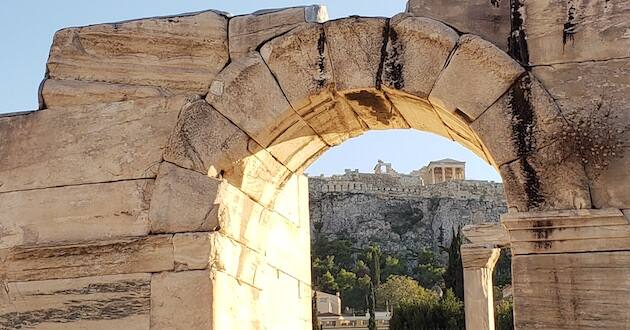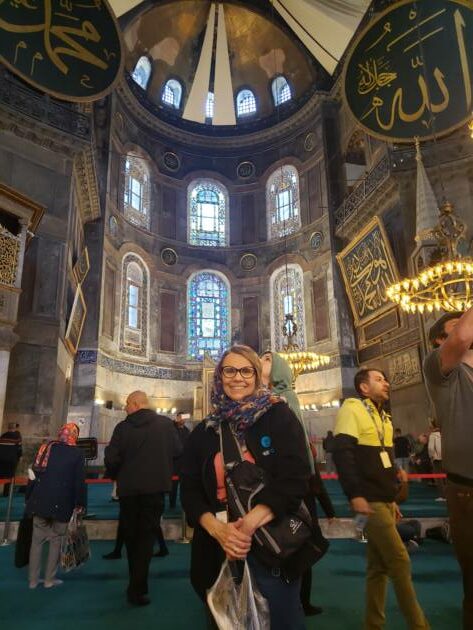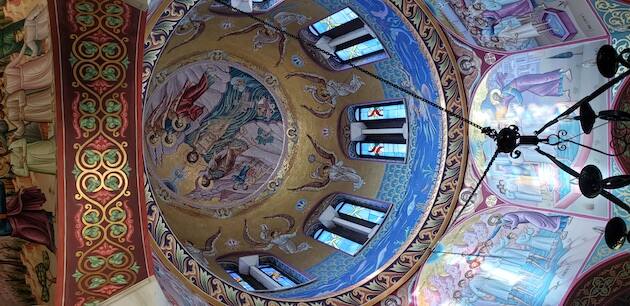We found the Apostle Paul on a Mediterranean cruise

Journey with us as we follow the Apostle Paul on a remarkable experience with Celestyal Cruises, tracing the spread of the Gospel to Europe and beyond.
Sometimes a sunset can change your life. Reach into your soul.
As I gazed at the mesmerizing Greek sunset, the colors cast in the sky and on the ocean’s edge reminded me of the nation’s abundant fruit crop. The water looked as red as the apples of Zagora. The flashes of fiery orange and amber in the azure sky resembled peaches from Naosa. As the sun rested on the horizon, shadows reminded me of island plums, and of course of olives, the official national fruit.
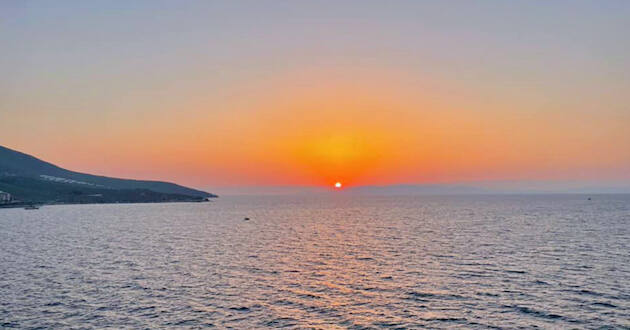
This spectacle wasn’t advertised as a feature on our daily Steps of Paul cruise itinerary, but perhaps it should have been.
For Hellenes, as proud Greeks still refer to themselves after 29 centuries, this blazing scene recalls the ancient story that Apollo, the mythical icon of light, poetry, and manly beauty, drove his sun chariot into the horizon at the close of each day.
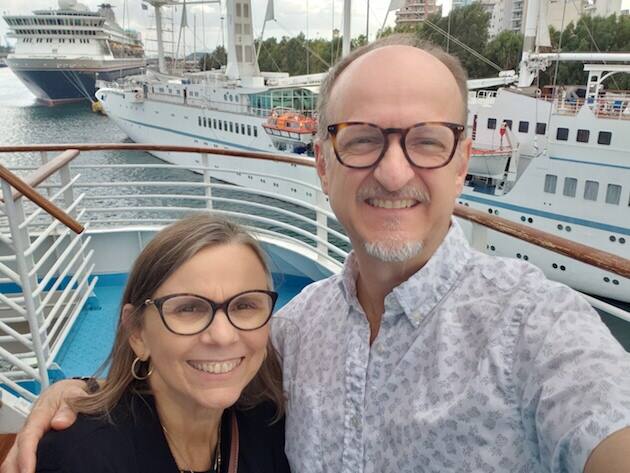
But for me, the glorious panorama went deeper, all the way to my soul. On this Steps of Paul cruise tour, I thought of the great Apostle, who doubtless watched similar sunsets under these very same skies. Greece, the land of fruitfulness. The land where the Apostle Paul planted seeds of the gospel underneath this same blazing sky. The land so near the sea, where Apollos watered and nurtured. And where God shone His glorious light to dispel spiritual darkness, so those plants bore fruit.
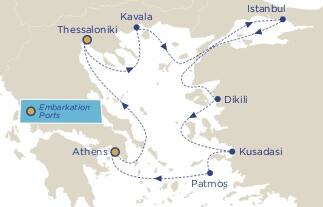
I wondered how many times Paul had watched this sunset, perhaps even while floating in a primeval boat, crafted from local wood and steered by the gentle rowing of the oarsmen.
While we occasionally saw boats that reflected the ancient days, thankfully, our craft was among the finest modern transportation, the majestic cruise liner, Crystal, part of the Celestyal Cruises fleet. Instead of the oarsmen, the motor quietly hummed as we moved to the next port.
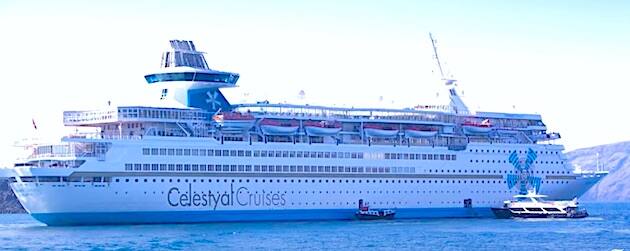
Master chefs would offer us delights created by Diane Kochilas of My Greek Table, as well as European and American favorites.
My wife, Anita, and I had enjoyed meandering through the quiet streets lined with tiny cars, modest homes, and villas with their showcase gardens overlooking the bay. Now we enjoyed our colorful respite and anticipated the gourmet meal ahead. Master chefs would offer us delights created by Diane Kochilas of My Greek Table, as well as European and American favorites. Tonight’s entrée options included Seafood Risotto with Champagne Sauce, Lemon-braised Lamb, Irish Angus Tomahawk Ribeye, Phyllo Pie, Stuffed Pork Loin Glazed with Pomegranate Balsamic, as well as appealing appetizers, scintillating side dishes, and delectable desserts—including a sampling of those Grecian fruits reflected in the sunset.
After a full evening of vibrant entertainment and crisp conversation, we would eventually rest in our comfortable cabin, refreshing our bodies and souls for another exciting day of pacing through Paul’s steps.
New Perspectives
If you ask people to describe their ideal image of Greece, some will inevitably conjure Instagram images of white-domed churches and colorful cottages nestled against rugged hillsides. Others will describe the Parthenon standing proudly atop sun-bleached ruins. Those with a cosmopolitan mindset might picture the rich and royal soaking the sun while lounging on languid beaches.

But Greece is so much more than a series of travel posters. Beneath the sunny surface, it and its neighbor, Turkey, offer a rich spiritual heritage and new perspectives of this popular destination.
Almost half of the New Testament was written by the Apostle Paul and much of that was addressed to people he’d taken the gospel to in cities across the Roman Empire: Philippi, Pergamon, Ephesus, Thessolaniki, cities included in the Celestyal Steps of Paul cruise.
Truly, if you want to explore Paul’s missionary journey, a cruise is the easiest and most comfortable way to enjoy a diverse itinerary featuring so many varied testaments of time. Cruising through Greece and Turkey, we saw the cradle of Western civilization like the seafarers once did. We marveled at the juxtaposition of sites of antiquity amid modern icons! And of course, our focus was finding the treasures of the burgeoning Christian world.
Cruising the Night Away
Thankfully, Celestyal’s Steps of Paul cruises set sail exclusively in October. This is the perfect time to enjoy Greece’s idyllic climate and balmy seas. Gone are the sweltering summer days, replaced by mild sunny days with gentle ocean breezes and pleasant evenings.
Also, gone are the hordes of summer tourists. Fall means fewer cruise ships, so ports and biblical sites were less crowded, more relaxing. For us, the experience was made even more special by the addition of a dear friend and her son who decided to join us. It was a blessing to share the exploration, memories and laughs with Renee and Stephen. When they learned we were taking the trip, they joined us without hesitation!
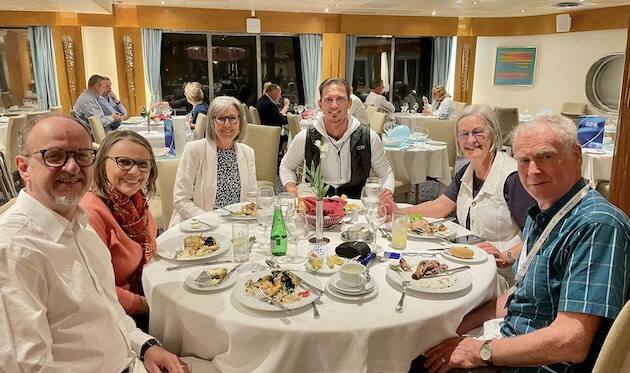
That eagerness may have been a combination of our friendship but also the extensive experiences that the cruise company provides.
Celestyal offers a wide variety of 7– to 14–day trips with options to include Egypt and Israel. Our seven-day voyage (with two nights in Athens before and a night after) took us through the Golden Age of Greek civilization and into the height of the Roman Empire, when Christianity began to grow. But the tour doesn’t forget the Byzantine and Ottoman empires.
We loved the idea of traveling to two continents in just over a week but without packing and unpacking. The cabin is your hotel room and it moves with you to each port of call. And forget the stressful details of figuring out how to get around in unfamiliar lands. The Celestyal team used years of expertise to plan every element—from minute to major—creating a carefree cruise that allowed us to focus on featured sites, food, and friends. Ahh! So lovely to feel the stress evaporate!
We were on the Crystal, which beckons the traveler to a bygone era of sailing. Rich wood tones provide luxurious warmth missing on so many liners. Whether you choose a cozy interior cabin, an exterior suite, or something in between, you’ll find comfy accommodations and perhaps even a bathtub—a rarity on today’s ships.
We felt like we were part of a “village” instead of being thrust into the massive, confusing city on the largest ships.
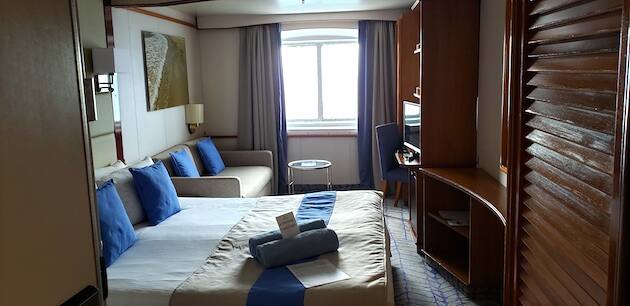
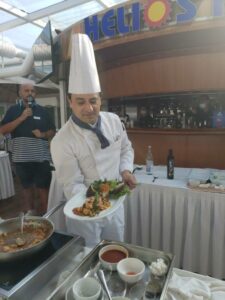 Celestyal’s faith-centered cruises typically host 800 to 1,000 guests. We felt like we were part of a “village” instead of being thrust into the massive, confusing city on the largest ships. The liner’s more manageable size also allows stops at smaller islands—like Patmos—that most cruise ships miss.
Celestyal’s faith-centered cruises typically host 800 to 1,000 guests. We felt like we were part of a “village” instead of being thrust into the massive, confusing city on the largest ships. The liner’s more manageable size also allows stops at smaller islands—like Patmos—that most cruise ships miss.
On the other hand, the cruise line offers all the perks of larger ships. Besides the award-winning dining, you’ll find plush on-board amenities, comfortable chairs that enhanced our ability to enjoy lively conversations, a wide variety of fun on-board activities, and evening entertainment with top-quality shows.
Another point of relaxation for us was that all charges, port expenses, and gratuities were included in our fees. The finances, like all other arrangements, were created to be worry-free for the traveler.
And there are those evening sunsets!
Paul: From Villain to Saint
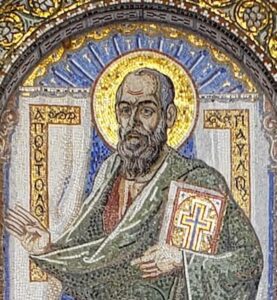
While preparing for the Steps of Paul cruise, I reflected on the Apostle Paul—possibly the most significant figure in the story of Christianity after, of course, Jesus.
Earlier known as “Saul of Tarsus,” he was a contemporary of Jesus, though the two never met. This devout Jew, who was also a Roman citizen, stepped into history after Christ’s resurrection and the growing movement of Jesus followers. His original goal was to purge Judaism of Jews who believed the Messiah had come in the form of Yeshua – Jesus.
One day, on his way to Damascus to persecute more Christians, Saul was blinded by a flash of light and the resurrected Jesus simply asked: “Why are you persecuting me?”
With that, Saul’s life was changed. He went from stoning Christians to ardently defending them and preaching their message of the risen Christ, which eventually led to his own persecution, imprisonment, and numerous attempts on his life. As he moved into reaching the Greco-Roman territory, he became more well known by the Latinized version of his name, Paul.
Paul made three amazing journeys to spread the gospel and teach both Jews and Gentiles about Jesus. He wrote letters to congregations in the early church to help them stay the course.
Paul consequently wrote more than half of what we know as the New Testament and formulated the message we still use today—continually focusing on the birth, death, and resurrection of Jesus and His redemptive power on the soul. Through Paul, the details of spiritual salvation took shape, and he defined central spiritual components of the Christian faith.
Paul’s work has withstood the test of time
Paul’s work has withstood the test of time. It has spanned geography, cultures, languages, and 2,000 years to form a global movement of believers now numbered at 2.5 billion people.
Amazing, right?

Paul did all of this on journeys that took him deep into the heart of Asia Minor—today’s Turkey—and onto the European continent including Greece, Italy, and possibly Spain. While his journeys were difficult, dangerous, and lasted years, our journey following him lasted just over a week with 21st century comforts.
Athens: Where History and Modernity Meet
Athens was our first stop in following Paul’s footsteps. We were mesmerized by the capital city, Athens, where ancient and modern blend. In 50 A.D., Paul’s time, it was already an ancient city of marble, including streets lined with grand temples and public buildings. Known as a center of philosophy and learning, its notables included Socrates, Plato, and Aristotle, who debated the nature of the universe and the meaning of life. How appropriate then, that Paul came around to join in that debate.
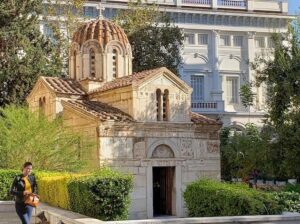 Like us, he would have climbed steps to the Acropolis, one of the world’s most recognizable sites, to stand at the entrance of the Parthenon. Our anticipation built with each step and the climb to the ancient gates was well worth it! The Parthenon was massive! Today, it is being meticulously restored, and its marble friezes and statues are returning home from museums around the world.
Like us, he would have climbed steps to the Acropolis, one of the world’s most recognizable sites, to stand at the entrance of the Parthenon. Our anticipation built with each step and the climb to the ancient gates was well worth it! The Parthenon was massive! Today, it is being meticulously restored, and its marble friezes and statues are returning home from museums around the world.
Paul also spent time at the Agora, or Roman Market in the Acropolis. Here, in the ruins we explored, Paul debated Stoic philosophers. He found receptive ears among the skeptical and was invited to speak on Mars Hill, a nearby outcropping of rock used for public addresses. Here, at the foot of the Acropolis and in the shadow of the temples to many gods, he explained to those gathered that the “uknown god” they had dedicated a temple to was really the God of the Bible.
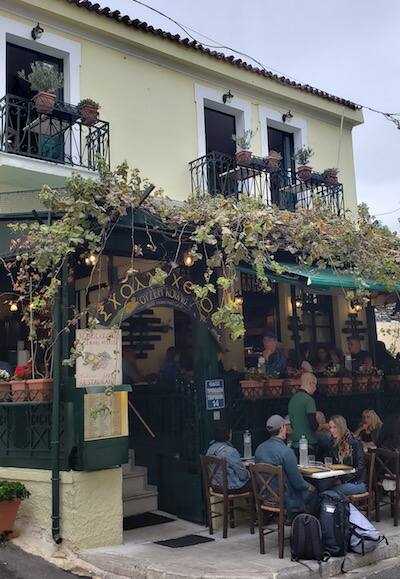
Some received his message and his legacy still exists in the little churches we discovered in Athens’ oldest neighborhood, the Plaka district. Its narrow cobblestone streets are lined with tiny houses in neo-classical pink, cream, and gray hues, charming cafes, and cozy shops that gave us a glimpse into traditional Greek life.
Next, we headed to the Acropolis Museum to see priceless artifacts, including the facades that once graced the Parthenon. The friezes and sculptures date back to the 13th century BC! What fun to see the original bust of Alexander the Great or Kritios Boy, a statue that has graced high school history books for two centuries. We learned that the nearby Electra Palace—a posh, mid-century hotel—is a great place to enjoy evening views of the Acropolis. We sat at the rooftop restaurant and chatted with travelers from around the world.
Of course we took traditional tourist selfies in front of the Greek Parliament building and other “modern” sites. Many on our tour enjoyed the Panathenaic Stadium where the first modern Olympic Games were held in 1896.
While so many of the sites of Athens appear familiar to us because of photos and videos, we discovered that seeing them in person was breathtaking. They were easy to navigate and we enjoyed unexpected finds from site to site.
Thessaloniki: Little Jerusalem
We actually first boarded the Crystal in Athens. The ship plied the waters of the Aegean towards our first port of call—Thessaloniki.
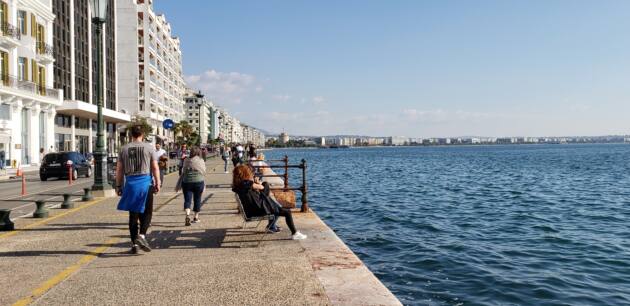
Paul preached here during his second missionary journey in 49 AD. In Thessaloniki Paul established a community of believers who quickly grew in their faith, despite persecution and suffering. His letter to them celebrated their steadfastness and encouraged them to stand strong and keep growing.
In Thessaloniki Paul established a community of believers who quickly grew in their faith, despite persecution and suffering.
You can almost hear echoes of that celebration as you visit the city’s impressive collection of Roman ruins, including an ancient marketplace and ampitheater. The city’s most famous monument is the White Tower, along the boardwalk. We really enjoyed the boardwalk, filled with locals pushing strollers, excited tourists, and the sound of the lapping waves in the background.

In Thessaloniki, you can choose one of the four half- or full-day excursions Celestyal offers there. We opted to go to the Macedonian town of Veria, (Berea in the New Testament), stopping at the Citadel on the way.
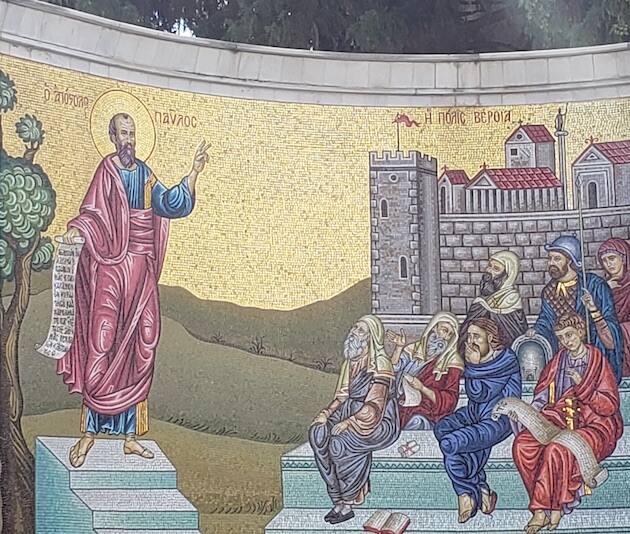
Our deluxe coach climbed coastal landscape ever, ever higher and then dipped into a valley to Veria, often called “Little Jerusalem” during the Byzantine era. It was considered to be a special place to Christians because of its affiliation with Paul. While not much is left of the ancient city, we were thrilled to stand on the steps Paul climbed to mount a speaker’s platform where he preached and many people became Christians.
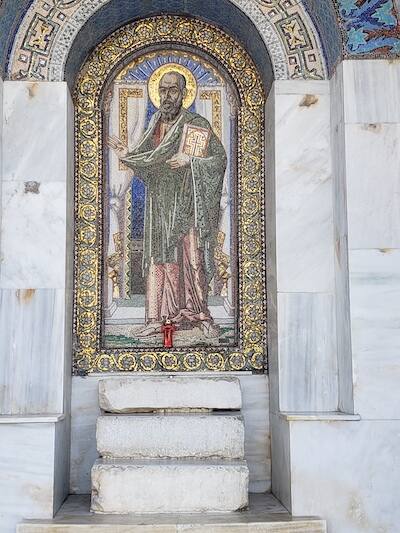
Veria is charming with its cobbled streets, stunning architecture, and bustling markets. Some of the cobbled alleys lead to the Apostle Paul’s Tribune (Bema), where he taught the locals, or to the Barbouta, a Jewish quarter filled with beautiful mansions—which Jews sold to the Greeks as they left the country at the beginning of World War II. While we were there, the city observed the Independence of Greece, and we enjoyed their parade of troops and boys scouts.
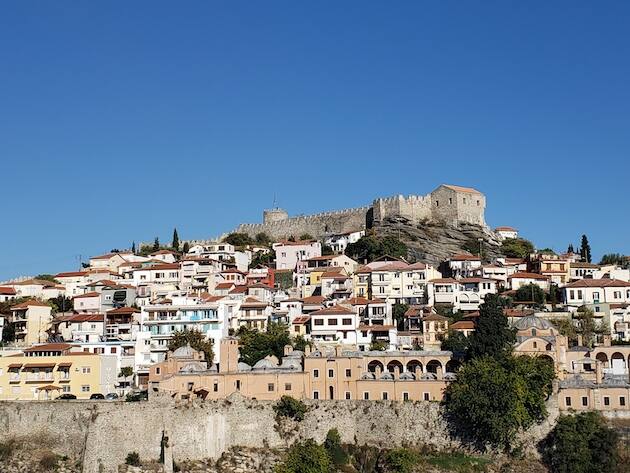
While traveling in Thessaloniki, the landscape is much the same as in Paul’s day and you can still see the Roman road, visible along the modern highway. As we returned to our ship, we again enjoyed the lovely promenade next to the water.
Kavala and Philippi Ahead
On Day 3 of the Steps of Paul cruise, the Crystal stopped at the port of Kavala. After exploring this picturesque city, which features beautiful beaches, we embarked on a half-day excursion to Neapolis and Philippi, in the present municipality of Filippoi
In Philippi, Paul established Europe’s first Christian church. He later wrote letters to the believers that are now some of the most quoted scriptures, words of rejoicing, praying instead of worrying, remembering they could do all things through Christ, and encouragement that God would meet all of their needs.
Once a thriving hub of commerce, today this is a fascinating archaeological site with impressive ruins, including an ancient forum where Paul preached, a theater, and a number of early Christian basilicas.
We especially relished the opportunity to explore a sweet little church built in honor of Lydia, the first European convert to Christianity. Flowers lined the path to the stream where Paul introduced her to the true water of life.
When we returned to Kavala, we walked with our friends Renee and Steven up the city’s main hill to a Byzantine castle. We paid a few euros to enter the castle, but the panoramic view of the city was worth it! There, we also marveled at the magnificent Roman aqueduct that spans an entire valley within the city. Another satisfying day!
Istanbul: The Crossroads of Time
After a short drive from the port, we were in the heart of Istanbul, a fascinating city at the crossroads of Europe and Asia that embraces two cultures. Once known as Constantinople, this is where Constantine “legalized” Christianity and the Roman Empire officially became a Christian “empire.” It was the seat of Byzantine Christianity, an empire that lasted over 1,000 years until the Ottoman Empire took over. Each of these periods had a profound impact on our faith and the development of Western civilization—perhaps as much as the influence of Greek democracy.
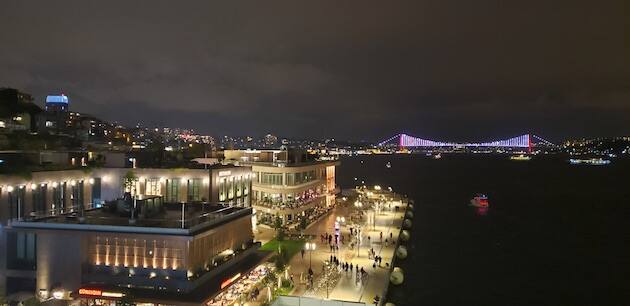
Celestyal offers three options for exploring the city, including a foodie tour aboard a boat that traverses the glistening, white-capped Bosporus Strait, which separates the Asian and European halves of the city.
The Hagia Sophia was once the largest building in the world—the Statue of Liberty could stand inside with room to spare!
I was anxious to visit the Byzantine-era Hagia Sophia (“Holy Wisdom”), a 1500-year-old building that was once a church, then an Ottoman imperial mosque, and now a museum. It was once the largest building in the world—the Statue of Liberty could stand inside with room to spare!
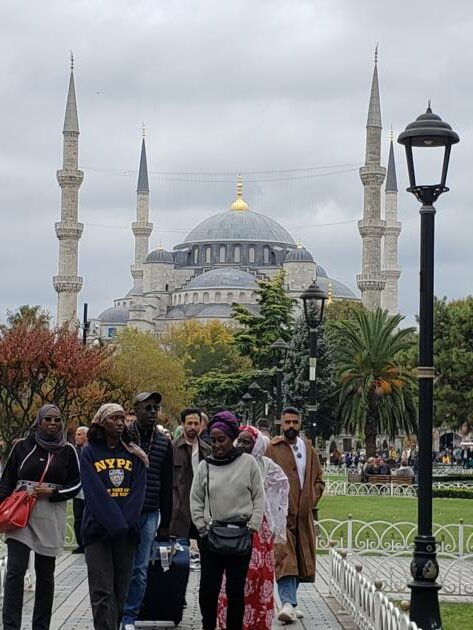
This wonder of the Byzantine world still dominates the Istanbul skyline. Forty windows surrounding a soaring dome inside allow warm light to penetrate into the farthest recesses. We joined both supporters and conquerors in admiring its intricate mosaics, marble pillars, and other-wordly ambiance. While some Christian iconography is covered, mosaics like the Saraphim Angels are clearly visible. The entire experience transports you back to the earliest centuries of Christianity.
Anita’s bucket list in Istanbul included the Blue Mosque, an iconic structure that looms over the city with six minarets appearing to scrape the clouds. Inside, we discovered plush, carpeted floors, elaborate calligraphy, and gorgeous stained-glass windows. The building’s intricate details and stunning blue tiles captivated us. We walked from that to the Obelisk of Theodosius, an ancient Egyptian structure once covered in gold. It was in the Hippodrome area, which was the social and political center for the city for almost 900 years, during Constatine’s era, so during the early days of Christianity.
But all this grandeur was just an appetizer for what was next!
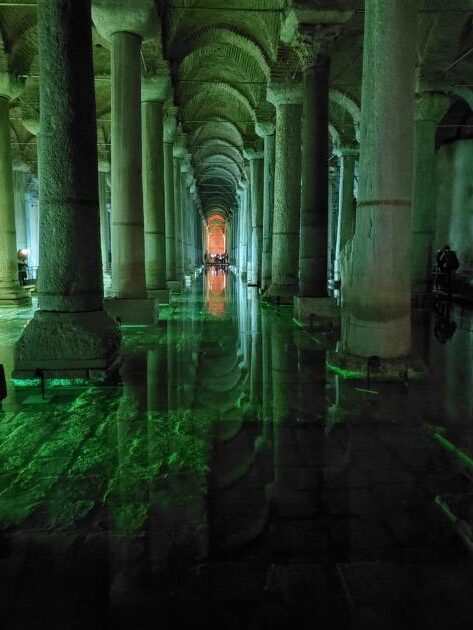
We headed below the bustling city streets to the Basilica Cistern—an underground water reservoir constructed in 532 to store up to 80,000 cubic meters of water! This well-loved tourist destination, also known as the Sunken Palace, is 50 percent larger than a football field. Amid the dim passages and haunting atmosphere, 336 massive marble columns seem to dance from the reflected water below to support the roof above, lined with arches and dotted by random ancient statues. Of course we followed tradition by tossing some American coins in the water.
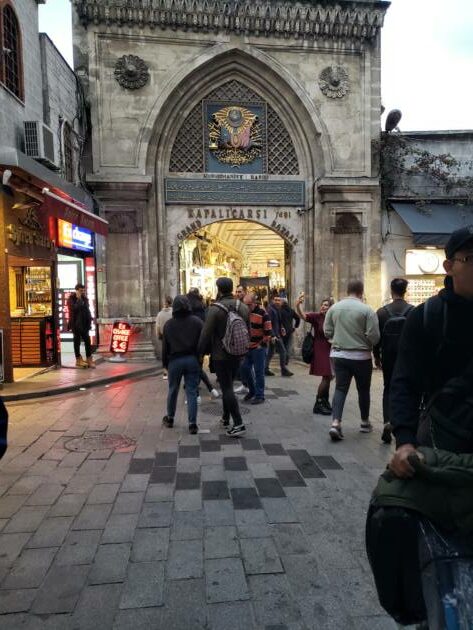

After lunch and a visit to the famous Grand Bazaar market, dating back to the 15th century, we explored the neighborhood and met friendly residents. The national warmth carried into a café where 20-something-year-old baristas resembled their American counterparts. They kindly helped us with the menu and served us strong Turkish coffee, along with a sweet treat and small bottle of water.
Of course no trip to Istanbul is complete without a bit of baklava, the most famous Ottoman dessert. Others may like the fermented drink, boza, with its blend of sweet and sour, topped with cinnamon and roasted chickpeas.
Our friend Stephen noted Christians miss a rich history of the Byzantine era and Eastern Orthodox faith. We were so blessed to see glimpses of that legacy in Istanbul.
Dikili: On the Road to Revelation
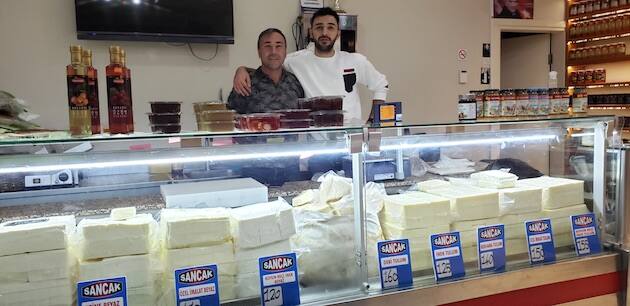
The energy changed the next day as we arrived at the Turkish port of Dikili. This is a working town that caters primarily to locals instead of tourists. In one store we found the famous Turkish Bergama Pergamon Cheese. The owner insisted we try a sample, along with Kopanisti, a goat cheese. We brought home enough to share with our family on a charcuterie board!
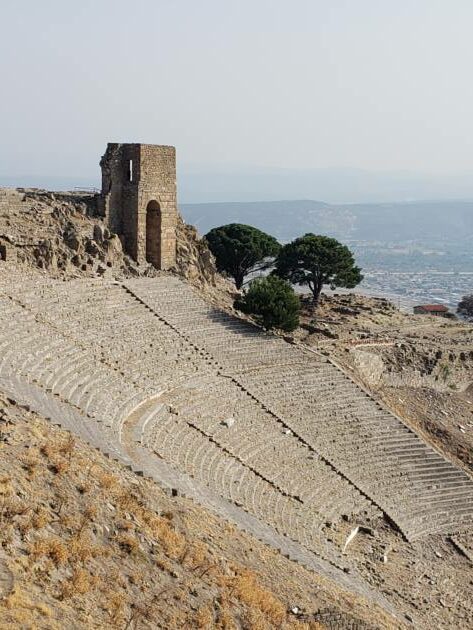
From Dikili, we journeyed to Pergamon. This was the location of the northernmost of the seven churches of Asia Minor, mentioned in the book of Revelation. The city, with parts sitting atop an acropolis that rises 900 feet, was a political and cultural center in the Byzantine era and was home to one of the largest libraries in the ancient world.
Pergamon was also home to Asklepion, one of the world’s first hospitals for Roman citizens in Paul’s day. In the ruins of the complex, you can imagine its open-air buildings connected by porticos, as well as a theatre for 3,500 spectators, lecture halls, and a library. I was fascinated by an ancient stone showing that the intertwined serpent image that would become the symbol of the Hippocratic oath and modern medicine.
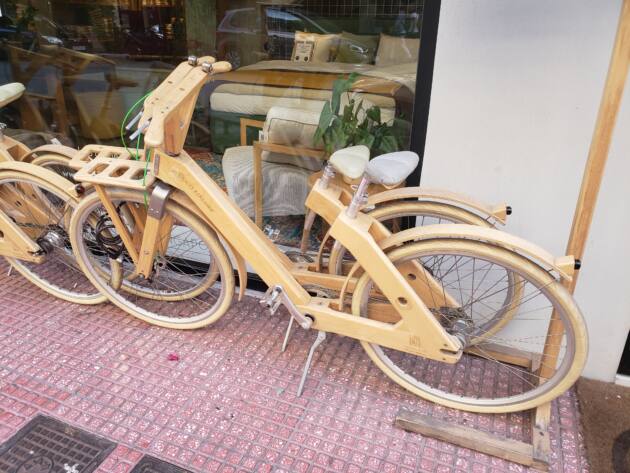
In Pergamon, the Great Altar of Zeus and Athena also intrigued me. This gave insight into the culture Paul lived. And the altar’s architectural framework is impressive! The structure is surrounded by columns and accessed by a grand staircase. The amazing marble frieze is 370 feet long and depicts the dramatic mythological battle between the Gods of Mount Olympus and giants. This represented a crucial shift from the ancient Greeks’ old religion, rooted in the natural world, being overthrown by “new” civilized Olympian gods.
Jesus applauded the Pergamene believers for holding fast to his name, even though they lived in the center of worship of pagan gods
In the Revelation letter John penned, Jesus applauded the Pergamene believers for holding fast to his name, even though they lived in the center of worship of pagan gods and pagan influences. However, he also told them to repent of false teachings. He promised to those who overcame, hidden manna, a white stone, and a new name, indicating a victorious reign with him.
A trip to Pergamon is sure to give a believer plenty of food for thought about social and spiritual battles! One thought resounded in my mind: Where are their gods today?
Kusadasi: Gateway to Ephesus
When we arrived at the Turkish port of Kusadasi, I felt tingles of anticipation. For our excursion that day would include the ancient city of Ephesus, a stunning marvel in the hills above the Aegean Sea.
Ephesus was the Roman Empire’s second-largest city and was filled with trade routes, temples, and libraries—second only to Alexandria in Egypt. Ephesus features one of the best-preserved archaeological sites in the world, with some of the most impressive structures of the ancient architecture: the Library of Celsus, the Great Theater, the impressive Faustina Baths, the imposing Nymphaeum, and one of the Seven Wonders of the Ancient World—the Temple of Artemis.
We were thrilled to again walk the same streets Paul once walked and think about the people he nurtured there.
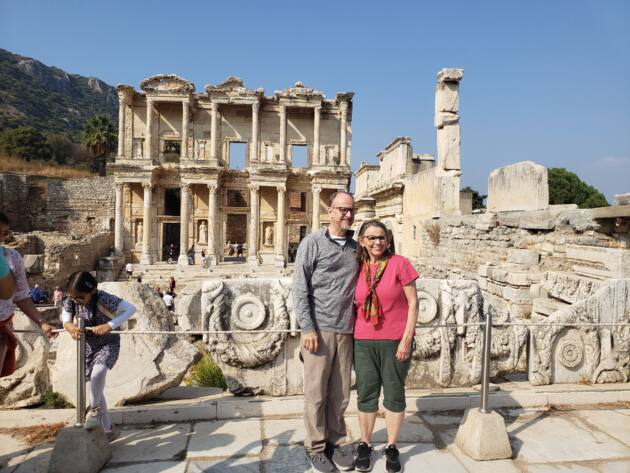
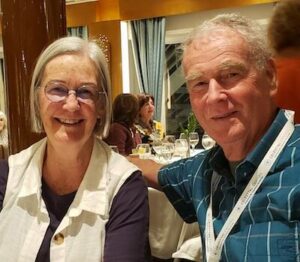
The ruins of the sprawling city offer a fantastic glimpse into Roman life in the “big city” and shed insight into the audience Paul was reaching. We were thrilled to again walk the same streets Paul once walked and think about the people he nurtured there. We were joined by our new friends Christine and Philip from New Zealand. To think Paul’s work would eventually reach far flung islands in the south Pacific was amazing. And our new Kiwi companions were a delight!
The church of Ephesus that Paul established became the head of the Seven Churches in western Asia Minor. Paul used this location as a central point for his ministry for about three years. I especially liked seeing the huge amphitheater where Apollos may have spoken ahead of Paul and the nearby agora. Apollos was eloquent and spoke boldly with great ferver, which created some competition between him and Paul.
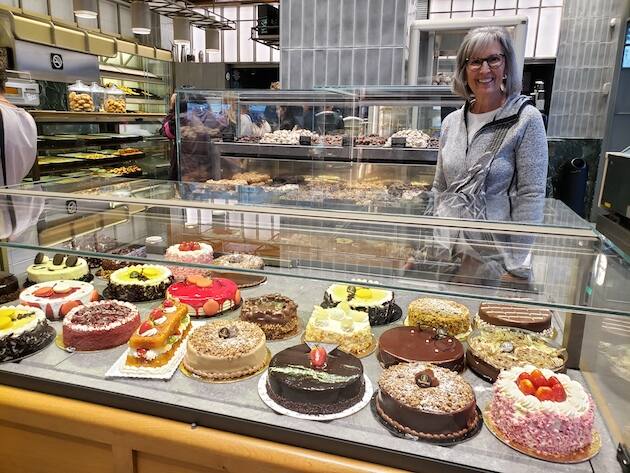
We also walked along roads Cleopatra and Marc Antony once walked. Mary, mother of Jesus, may also have lived here, if she was still alive when Romans forced Jews out of Israel in 70 AD. During that brutal crackdown of the Jewish revolt, towns like Nazareth, Bethlehem, and Jerusalem were destroyed with their residents killed or dispersed.
Next, we went to the ancient coastal city of Miletus, another of the greatest and wealthiest cities in Ancient Greece and one of the first to mint coins. Homer mentioned Miletus in The Iliad and Paul preached here on the way back to Jerusalem.
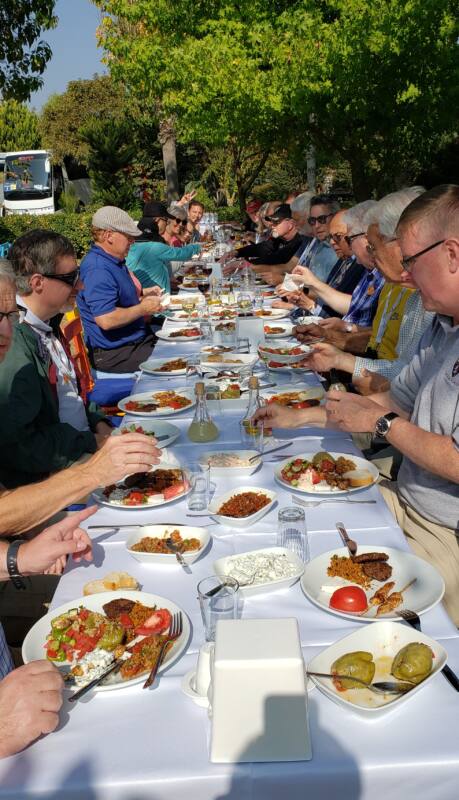
No doubt he saw the same landscape we saw, with villages and people of the time along the way. Our group stopped at a rug factory where we saw demonstrations and learned why Turkish rugs have been in high demand since the 13th century. The women creating them were truly artisans.
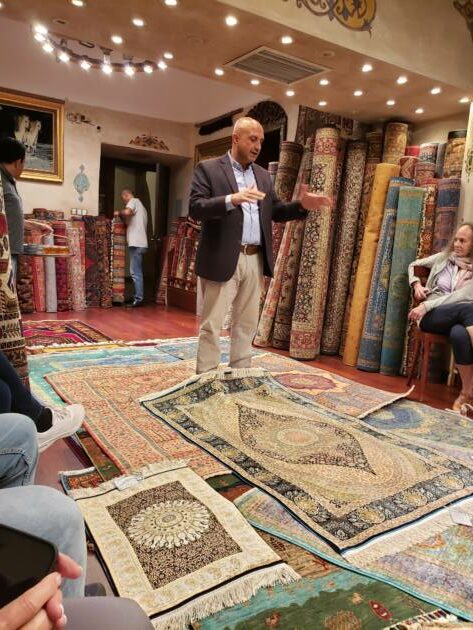
Patmos: Where a Friend Showed Up
Our last port of call was Skala on the Greek island of Patmos. Sitting just off the coast of Turkey, this rocky outpost island was originally a penal colony for the Roman Empire. Here Rome sent its most violent criminals to work the quarries and fend for themselves against the elements. It was a cruel and unyielding environment, and most did not survive. How unjust that John was exiled here in his old age.
If Jesus had a best friend, it was John. Scriptures show us their close relationship, with 1 John 11 affirming that John was the disciple Jesus loved.
Readers who want to experience this itinerary can take advantage of a special offer available from now until May 31 for the October 14th, 2023 sailing at the reduced price of $1,389, per person (normally priced at $1,650, per person) for an interior double occupancy stateroom. This includes all onboard dining, select beverages with meals, an $80 discount, per person, to be used towards a pre-booked shore excursion of your choice, onboard entertainment, and all gratuities, port, and service charges. For an additional $260, per person, you can upgrade your cruise to the Enhance Fare, which includes a 25 percent discount on speciality dining, a $160 shore excursion discount per person, one hour of free Wi-Fi per day and a premium drinks package.
For more information or to book your cruise, consult your travel advisor or visit celestyal.com
But while John was here, alone and facing death—maybe even thinking he had been forgotten— his friend Jesus showed up. John wrote in Revelation 1:17 that upon seeing Jesus, he fell at his friend and Lord’s feet. Jesus put his hand on John’s shoulder and instructed him to write down the vision he had experienced of what was to be, as well as his words to his Churches. John was not forgotten, and Jesus still needed him.
So here, in a cave, the last living disciple wrote his Gospel of John and the Book of Revelation
So here, in a cave, the last living disciple wrote his Gospel of John and the Book of Revelation—the final book of the New Testament.
We stood in the cool, dim cave where John received the Revelation and a visit from the resurrected Jesus. Surrounded by other visitors from around the world, I was overwhelmed by the fact that Jesus showed up for his friend. In silent praise I remembered: God is there for us at our darkest hours.

The cave where John wrote was later converted to a beautiful and splendidly adorned chapel on the site of the Monastery of St. John, and is now a UNESCO World Heritage site. Inside a small but impressive museum, we viewed priceless icons, manuscripts (including a 6th century copy of the Gospel of Mark), medieval textiles, and ancient Bibles. Monks still call this home after 1088 years, and you can see where they gather for meals as you walk across the sunny, breezy courtyard.
After the visit to the cave, some of our tour friends took the coach back to the port, but we walked to the quaint old town of Chora, the small island’s capital. It features what looks like a huge castle, but is the Monastery of St. John the Theologian, perched at the top of the island. I thought the monastery’s dark stone and buttresses contrasted nicely with the interior’s beautiful frescoes and the surrounding village adorned in white.
Chora doesn’t see many tourists, since the larger ships can’t dock at the island. No cars are allowed in the center of town, so it’s foot-traffic only, and you can see how the locals live.
Some people hale a taxi for the 7-minute ride to the port, but our trek on foot only took 30 minutes on this remarkably walkable island. As we walked, we surveyed distant islands of the archipelago and yet another amazing sunset.
After Patmos it was nearly time to say goodbye. The final night was capped with a special celebration, and we went to bed with mixed emotions—part of us wishing the cruise would go on forever.
The Piece de resistance
The next morning the Crystal returned to port in Athens, but there was no need to rush away. Celestyal Cruises offers excursions to yet one more location featuring the life of St. Paul. You can choose between the ancient Corinth and the Bema of St. Paul or enjoy highlights of the ancient Acropolis.

Since you’ve most likely explored the Acropolis, you’ll want to visit Corinth, roughly halfway between Athens and Sparta.
During the 6th century BC, Corinth was one of Greece’s richest cities. Located in the northeast corner of the Peloponnese and at the head of the Gulf of Corinth, the city controlled the narrow Isthmus and the seas on each side. In Paul’s time, Corinth was a center of trade, and even had a naval fleet. The city was known for architectural and artistic innovations, including the invention of black-figure pottery. Corinth was home to a large, mixed population of Romans, Greeks, and Jews.
Your first stop is the Corinth Canal. Built between 1881 and 1893, the 70-foot-wide, four-mile-long waterway cuts through the Isthmus of Corinth and follows much the same line as a canal planned in Roman times.
The city was destroyed by an earthquake in 1858, with the main sites today being only the ruins of the Temple of Apollo, built in 540 B.C., and the massive, steep rock of the Acrocorinth, rising 1800 feet above the surrounding plain. Throughout ancient and medieval times, Acrocorinth was topped by a fortress—the most important fortification work in the area until 1821.
Monks continue to use this courtyard for evening meals, centuries after it was built.Only seven columns of the Temple of Apollo remain standing, although we could still see elements of the building’s ground plan visible in the bedrock cuttings. Excavations, begun in 1896, are still ongoing.
St Paul established a church in Corinth about 50-52 AD. Later, he had so much to write to the Corinthians that his writings became two books in the New Testament. He addressed such important topics as divisions among believers, food, sexual integrity, worship gatherings, and the truth of the resurrection.
In Corinth Paul also met Aquila and Priscilla, Jews who had been expelled by Emperor Claudius from Rome. These three were tentmakers and may have set up their business in the city’s commercial marketplace. They undoubtedly enjoyed plenty of interaction with the townspeople to tell them about the resurrected Christ.
But not all people who heard Paul’s messages were pleased. The elders in Corinth’s synagogue accused him of subversive teaching against the Mosaic Law and brought him before the proconsul Gallio at the city’s place of judgment, the Bema. This was just one of the times Paul was brought before officials for preaching the gospel, and in Corinth, Gallio judged that his teaching did not constitute an offense against Roman law.
I whispered a prayer that I may always be as bold and faithful as Paul.
Before we left the area, I considered the Bema and could almost see Paul confidently standing up for his faith. I whispered a prayer that I may always be as bold and faithful as Paul.
Stepping Into the Future

Our tour coming to a close, we relished the remaining time exploring the picturesque alleys and shops back in Athens. We talked about the indelible mark Paul had left on Athens and humanity. His message of faith, hope, and perseverance brings encouragement in difficult times. Maybe that’s why he resonates with Greeks who have faced their own difficulties in recent decades.
And through The Steps of Paul cruise, the life of the Apostle resonated in my own life more deeply. While tours of the Holy Land have opened my heart more vividly to the magnificence and miracles of Jesus, there’s more to the Messiah’s story. The Steps of Paul tour takes us into the next chapter of the story, the spread of the Church. The Steps of Paul tour brought this chapter of Church history to life. It was a historical, cultural and Biblical tour de force
Our Steps of Paul Cruise took us even farther, spiritually, than exploring Paul’s own journey to Athens and other cities. We literally walked in the footsteps of many of the heroes of the faith!
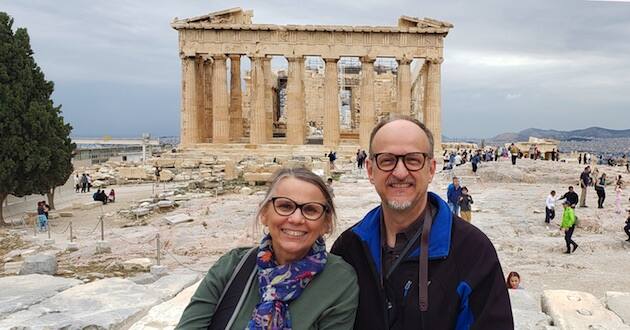
I pondered over this as we gathered our suitcases and prepared to re-enter the 21st-century world with its normal demands. But I paused that night to watch one more Grecian sunset. Yes, it still reminded me of a plethora of plums, olives, and peaches.
My insights from the Steps of Paul cruise would take weeks to unpack, and I would pour through New Testament writings with new eyes now.
In all, we found the Steps of Paul cruise with Celestyal Cruises to be abundantly, overflowingly fruitful . . . even more brilliant and fruitful than a Grecian sunset.
–Dwight and Anita Widaman | Metro Voice



